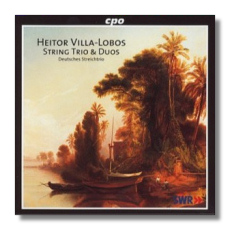
The Internet's Premier Classical Music Source
Related Links
- Villa-Lôbos Reviews
- Latest Reviews
- More Reviews
-
By Composer
-
Collections
DVD & Blu-ray
Books
Concert Reviews
Articles/Interviews
Software
Audio
Search Amazon
Recommended Links
Site News
 CD Review
CD Review
Heitor Villa-Lôbos

Chamber Works
- String Trio for Violin, Viola and Cello (1945)
- Duo for Violin and Viola (1946)
- Deux Chôros for Violin and Cello (1929)
- Chôros #2 for Violin and Cello (1924)
Deutsches Streichtrio
CPO 999827-2
The most substantial work here is the leadoff piece, the 1945 String Trio, Villa-Lôbos' only string trio in a catalogue rife with chamber works, including seventeen complete string quartets. In this latter genre the composer surpasses the output of even the prolific Dmitri Shostakovich. And Shostakovich comes to mind for other reasons here too: while Villa-Lôbos shares little stylistically with his Russian counterpart in this Trio, he gives his work an angst and at times an intractable veneer that are spiritually related to the late Shostakovich quartets.
The Allegro first movement has a grimness of expression in its generally agitated character and features some jolting dissonances. The second panel opens with a lyrical, even lovely theme, but the movement overall has a dark melancholy manner. Things seem to brighten in the ensuing Scherzo (Vivace), but it too becomes agitated, and much the same manner prevails in the Allegro preciso finale. But here there emerge a vague sense of triumph, of resolution to the accrued tension as the movement proceeds. But the final buildup, rhythmic and insistent and sinister, eventually tumbles downward only to ascend, leaving the listener with a sense of ambivalence. Was the concluding war on the composer's mind in this work?
Of the other compositions here, the 1946 Duo for Violin and Viola is probably the most rewarding. Its expressive language is slightly less complex than the Trio's, and its mood is somewhat brighter. Cast in three movements, it is quite a worthwhile effort, not least because of its haunting and deftly atmospheric Adagio middle panel. The two-movement Deux Chôros and the brief Chôros #2 (originally conceived for flute and clarinet) come almost from different worlds: they are lighter and feature Latin flavors and an exotic sense in their imaginative scoring. The sound on the disc is excellent, and CPO provides informative, if somewhat brief notes.
Copyright © 2002, Robert Cummings


















